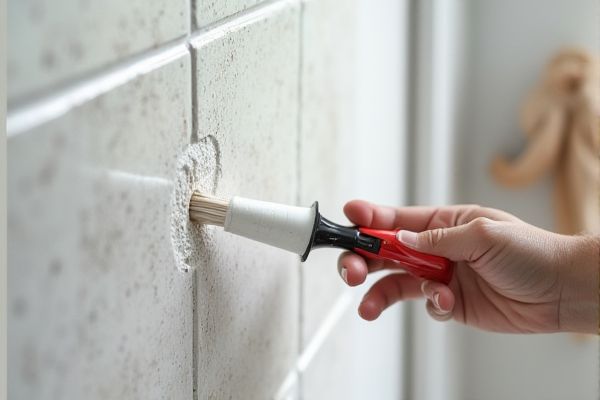
Grout is a cement-based material used to fill gaps between tiles for a rigid, waterproof seal, while caulk is a flexible, silicone or latex-based sealant ideal for sealing joints that experience movement. Understanding the differences between grout vs caulk can help you choose the best option for your home improvement project; explore the rest of the article to learn more.
Table of Comparison
| Feature | Grout | Caulk |
|---|---|---|
| Material Type | Cement-based, powder mixed with water | Flexible sealant, silicone or latex-based |
| Primary Use | Filling gaps between tiles | Sealing joints and cracks, especially where movement occurs |
| Flexibility | Rigid and hard once dry | Highly flexible and elastic |
| Water Resistance | Water-resistant but can crack over time | Waterproof and resistant to mold and mildew |
| Durability | Durable in static areas, prone to cracking in moving joints | Long-lasting in areas with movement |
| Application Areas | Bathrooms, kitchens, floors, walls | Edges of tubs, sinks, countertops, windows, doors |
| Maintenance | May require resealing and repair | Easy to remove and replace |
| Appearance | Available in various colors, matches tile | Usually white or clear, available in colors |
| Cost | Generally lower cost per application | Moderate cost, depends on type |
Grout vs Caulk: Key Differences
Grout is a cement-based material primarily used to fill the gaps between tiles, providing structural strength and durability, while caulk is a flexible, silicone or acrylic sealant designed to seal joints and prevent moisture intrusion. Grout hardens to form a rigid surface that resists wear and movement, making it ideal for areas subjected to heavy foot traffic, whereas caulk remains pliable to accommodate expansion and contraction in corners or along edges. Understanding the differences in composition, application, and flexibility helps determine the appropriate choice for tiling versus sealing needs.
What Is Grout? Definition and Uses
Grout is a dense, cement-based material used to fill gaps between tiles, providing structural stability and preventing water infiltration. It is commonly utilized in bathrooms, kitchens, and flooring applications to create a durable, sealed surface. Your tiled surfaces benefit from grout's ability to enhance strength and resist mold and mildew in wet environments.
What Is Caulk? Definition and Applications
Caulk is a flexible sealing material used to fill gaps and joints, preventing water, air, and pest infiltration in buildings. Commonly applied around windows, doors, sinks, and tubs, caulk adapts to movement and expansion, making it suitable for dynamic spaces. Unlike grout, caulk remains pliable after curing, ensuring long-lasting watertight seals in areas subject to shifting or vibration.
Grout Properties and Benefits
Grout is a cement-based material known for its durability, water resistance, and ability to fill gaps between tiles, providing structural stability and preventing moisture infiltration. It hardens into a rigid, long-lasting surface that withstands heavy foot traffic and daily wear, making it ideal for floors and shower walls. Its porous nature can be reduced with sealants, enhancing stain resistance and extending the lifespan of tiled surfaces.
Caulk Properties and Benefits
Caulk offers superior flexibility and waterproofing compared to grout, making it ideal for sealing joints and gaps in areas prone to movement or moisture, such as around bathtubs, sinks, and countertops. Its ability to expand and contract prevents cracks and mold growth, ensuring long-lasting protection and durability. You can easily apply caulk to create a smooth, airtight seal that maintains both aesthetic appeal and functionality in your bathroom or kitchen.
When to Use Grout
Grout is best used to fill the spaces between tiles where a hard, durable seal is needed to prevent water and debris from entering, especially on shower walls, floors, and backsplashes. Unlike caulk, grout provides structural support to the tile installation and is ideal for areas subject to heavy foot traffic or moisture. You should choose grout when a long-lasting, rigid finish is required to maintain tile integrity and prevent shifting or cracking.
When to Use Caulk
Caulk is ideal for sealing joints where two different surfaces meet, such as around bathtubs, sinks, and countertops, providing a flexible, waterproof barrier that accommodates movement. Use caulk in areas prone to expansion, contraction, or slight shifting to prevent cracking and water intrusion. It is especially effective in corners and edges where grout may fail due to its rigid composition.
Common Mistakes: Grout vs Caulk Confusion
Confusing grout with caulk often leads to improper application, as grout is designed for filling gaps between tiles, while caulk seals joints and edges against moisture. Using grout in areas that require caulk can result in cracking and water damage, whereas caulk applied between tiles may not offer the necessary strength or durability. Your best choice depends on the location and function of the joint to ensure long-lasting, water-resistant results.
Maintenance and Longevity: Grout vs Caulk
Grout offers superior durability and long-term resistance to wear, making it ideal for high-traffic or moisture-prone areas, though it requires periodic sealing to prevent cracking and staining. Caulk provides flexible, waterproof sealing that accommodates movement and prevents mold growth, but it generally needs more frequent replacement or touch-ups due to shrinking and cracking over time. Choosing between grout and caulk depends on balancing maintenance frequency with longevity needs in the specific application area.
Choosing the Right Material for Your Project
Selecting grout or caulk depends on the specific needs of your project, with grout offering a durable, water-resistant fill ideal for tile joints in floors and walls, while caulk provides flexible sealing perfect for areas prone to movement such as bathroom edges and countertops. Grout's hardness and resistance to wear make it suitable for high-traffic surfaces, whereas caulk's elasticity accommodates expansion and contraction, preventing cracks and leaks. For best results, use grout in stable, fixed joints and caulk where flexibility and waterproof sealing are essential to maintain structural integrity and aesthetics.
 homyna.com
homyna.com